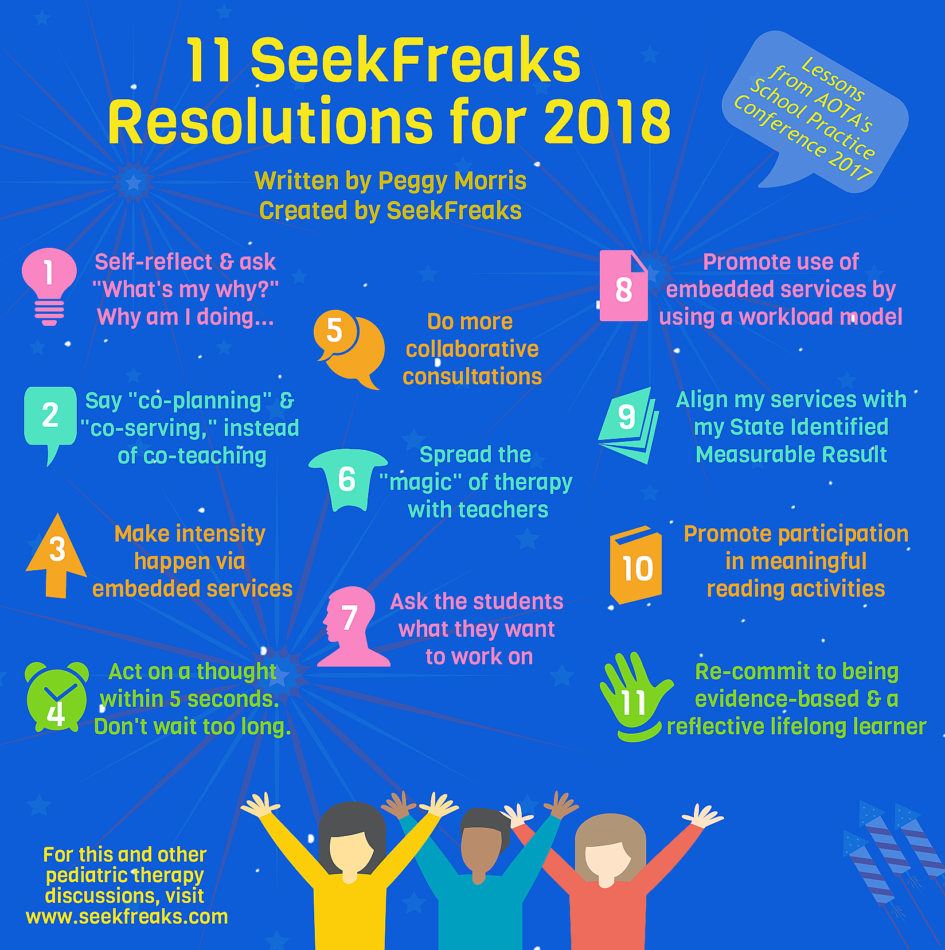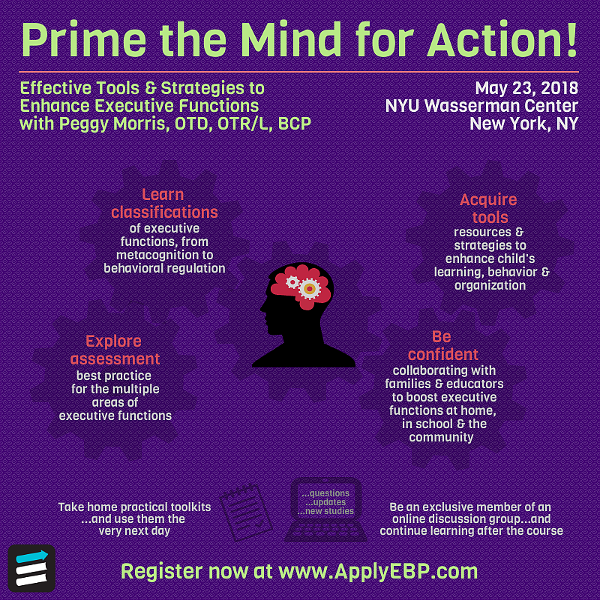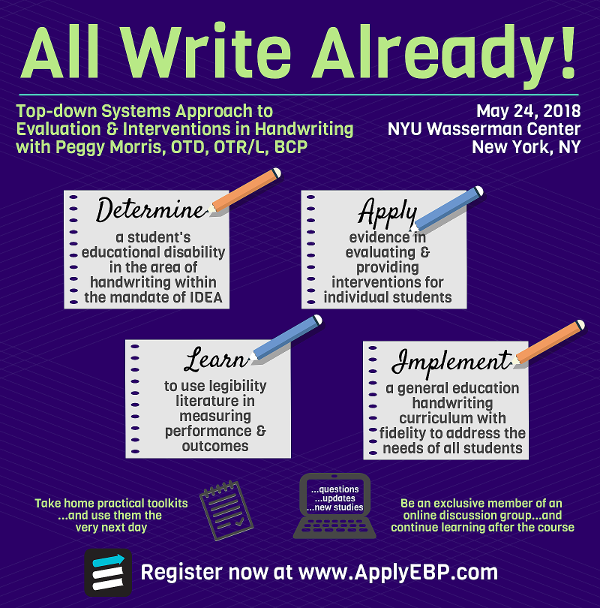Hello there! I recently spent a lovely long weekend in Orlando, Florida, to attend the AOTA’s specialty conference for school therapists. It was well attended; over 400 folks participated, along with thousands (or so it seemed) of Irish step-dancers. If you were there, you know!
The multiple keynotes focused on student participation in school and the concurrent sessions focused on how we support that educational role for our clients. Our keynote speakers spoke of educational change (titled Moving Mountains! How apt!), building routines for contextual and collaborative practices, systems change, and ethical practice in schools.
Hot topics included workload versus caseload, inclusive practices for social participation, data-based decision-making, and quality indicators for competencies in schools practice, Medicaid in schools, and literacy as occupational justice (yup, that one BLEW my mind, in an oh-so-good way).
Here are just a few snippets from my notes, which also works well as SeekFreaks Resolutions for 2018, whether you are an OT, PT or Speech service provider. Which ones will you adopt?
- Self-reflect & ask “What’s my why?”
- What’s my Why? Cathy Csanyi referenced Simon Sinet’s TedTalk: Start with Why as she urged the conference participants to ask ourselves: Why are we pulling students out of class? Why are we doing a medical model? Why are we pigeon-holed in sensory and early childhood and handwriting? Heavy, heavy questions. Sometimes, I think the answers to these Why questions are easy; it is the change implementation that can be tricky.
- Use the words co-planning and co-serving
- Co-planning and co-serving are the new educational buzz words. As we head into providing more and more contextual service within natural environments, rather than ‘co-teaching’, use this new vocabulary!
- Make intensity happen via embedded services
- Intensity can happen with embedded services. Hmmm, think about this one. And then head to everymomentcounts.org for a gander. Every Moment Counts is a model program for embedded school mental health promotion services. As mental health providers, school-based occupational therapists are the backbone of this initiative, as they model and build capacity in all school personnel to address social and emotional aspects for participation for everyone at school. Go to the website, check out the FREE resources for Comfortable Cafeteria or Refreshing Recess. And then bookmark it and revisit often. It is a project under continual growth and expansion. Go! 5-4-3-2-1
- Act on a thought within 5 seconds
- That 5-4-3-2-1 is a reference to Mel Robbins’ 5-second rule (no, not the one for how long snack can stay on the floor and still be OK to eat!). When you have a thought, you have 5 seconds to act on it, or you probably won’t. Just good advice for everyone seeking change. SeekFreakers!
- Do more collaborative consultations
- Collaborative consultation is not less than direct service. There is enough evidence to date that demonstrates students meet their goals equally when therapy is delivered through either.
- Spread the “magic” of therapy with teachers
- The key to flourishing in schools practice is participation in everyday school routines. We can’t keep our ‘magic’ out of sight in the therapy room, under the stairs, in the basement, or on the stage. Teachers need to see our ‘magic’ to know that it isn’t really magic! It is the way we think, what we observe, and how we analyze function that is our special sauce. Spread the knowledge of the sauce!
- Ask the students what they want to work on
- This is one of my favorites! Buy-in equals motivation.
- Promote use of embedded services by using a workload model
- Workload is a public health model that allows for embedded services, collaboration, consultation, meeting individual student and teacher needs. For more info, check out this SeekFreaks column.
- Align my services with my SIMR
- What’s your SIMR? SIMR is State Identified Measurable Result. Each state has identified, as part of their systematic improvement plan for students with disabilities, an outcome for which data will be collected and analyzed to determine need and measure progress. AOTA has a list of SIMRs by state. Check out your state’s SIMR: does your service align with your SIMR? Approximately half of the identified SIMRs relate to literacy/reading/language arts outcomes.
- Promote participation in meaningful reading activities
- Which segues nicely to literacy as occupational justice. Lenin Grajo delivered a wonderful presentation on literacy and OTs’ potential role at school within this area. Now, if you are anything like me, you are thinking – “Literacy? Really? So not equipped to think about literacy. I am not a reading teacher. What do I know about reading?” Sitting with an almost-open mind (J) during his talk, he convinced me to think first about literacy as occupation. Literacy is embedded in all areas of occupational performance: think job applications, furniture assembly directions, reading maps, medication instructions. Functional literacy is required within the context of home, school, and community. OK, I’m in. So, the occupational justice piece? Occupational justice is the “right of every individual to be able to meet basic needs and to have equal opportunities and life chances to reach toward his or her potential” through “engagement in diverse and meaningful occupations” (Wilcock & Townsend, 2008, p.193). Well, that’s a good mantra! Some specific service professionals probably think and work and breathe that way! Wink! Wink! So, literacy as a human right; functional literacy as embedded within every occupation and every context. How can we NOT think we have value to offer in this area for our students? I’m way in now. Grajo shared evidence of impacts of literacy problems in children, including increased behavior problems, including reactivity and aggression, increased distractibility and inattentiveness, anxiety and depression, withdrawal and isolation. We are so able to work with students with literacy challenges to build their adaptive capacity. Dr. Grajo and his colleague, Dr. Catherine Candler, have developed a model for participation in this area, called The Occupational and Participation Approach to Reading Intervention (OPARI). Generally, the aims of the intervention model revolve not around remediation of reading issues, but rather participation in meaningful reading activities. Now I can certainly do that! There are some references below if you desire more information on this model.
- Re-commit to being evidence-based and a reflective lifelong learner
- I think Patricia Laverdure left me with one of the more memorable nuggets during her presentation of promoting effective school practice: “Effective school OTs are evidence-based and reflective life-long learners.” To that end, I am excited to share that the AOTA specialty conference for schools practice will be an annual event; watch AOTA’s website for an announcement or follow AOTA on Twitter @AOTAinc. See you there!
Join the author, Peggy Morris, in NYC for Prime the Mind for Action! (May 23) and All Write Already! (May 24). Save during Apply EBP’s January Launch Special.
References:
Grajo, L., & Candler, C. (2014, July). Children with reading difficulties: How occupational therapy can help. OT Practice, 19(13), 16–17.
Grajo, L., & Candler, C. (2016a). An occupation and participation approach to reading intervention (OPARI) part I: Defining reading as an occupation. Journal of Occupational Therapy, Schools, and Early Intervention, 9(1), 74–85. doi:10.1080/19411243.2016.1141082
Grajo, L., & Candler, C. (2016b). An occupation and participation approach to reading intervention (OPARI) part II: Pilot clinical application. Journal of Occupational Therapy, Schools, and Early Intervention, 9(1), 86–98. doi:10.1080/19411243.2016.1141083
Grajo, L., & Candler, C. (2017). The occupation and participation approach to reading intervention (OPARI): A community of practice study. Journal of Occupational Therapy, Schools, & Early Intervention, 10:1, 90-99, DOI: 10.1080/19411243.2016.1257967
Wilcock, A. A., & Townsend, E. A. (2008). Occupational justice. In E. B. Crepeau, E. S. Cohn, & B. A. B. Schell (Eds.), Willard and Spackman’s occupational therapy, (11th ed., pp. 192–199). Philadelphia: Lippincott Williams & Wilkins













January 12, 2024 at 3:07 pm
commment